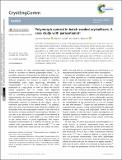Polymorph control in batch seeded crystallizers. A case study with paracetamol
Author(s)
Nicoud, Lucrece Helene; Licordari, Filippo; Myerson, Allan S.
Downloadc8ce01428k.pdf (3.632Mb)
PUBLISHER_CC
Publisher with Creative Commons License
Creative Commons Attribution
Terms of use
Metadata
Show full item recordAbstract
Controlling crystal polymorphism is crucial in the manufacturing of pharmaceuticals. In this work, we combine experimental characterization (including online imaging, infrared and Raman spectroscopy) with population balance modeling to investigate polymorph formation in batch seeded crystallizers considering paracetamol as a model system. We show that seeding the crystallizer with the target polymorph (here form II) does not necessarily lead to the intended polymorphic outcome. It is found that a decrease in temperature and in the stirring speed both allow improving the yield–purity trade-off thanks to a decrease in the nucleation rate of form I. The temperature leading to the most productive process is shown to be strongly dependent on the target polymorphic purity, namely the optimal temperature decreases with increasing purity specifications.
Date issued
2018-10Department
Massachusetts Institute of Technology. Department of Chemical EngineeringJournal
CrystEngComm
Publisher
Royal Society of Chemistry (RSC)
Citation
Nicoud, Lucrèce et al. “Polymorph Control in Batch Seeded Crystallizers. A Case Study with Paracetamol.” CrystEngComm (October 2018) © 2018 The Royal Society of Chemistry
Version: Final published version
ISSN
1466-8033